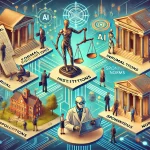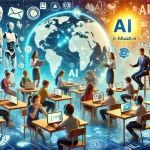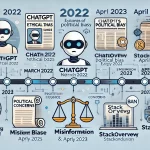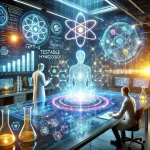
Top 10 Transformative Integrations of AI into Bioinformatics in 2024
December 29, 2023Introduction: Navigating the Bioinformatics Frontier with Artificial Intelligence
In the intricate realm of bioinformatics, where biology converges with informatics, a dynamic landscape unfolds at an unprecedented pace. The synergy of biology, data, and computational prowess propels us into a realm of discovery, offering profound insights into the intricacies of life itself. As we stand on the cusp of groundbreaking advancements, the evolving nature of bioinformatics unveils a tapestry woven with the threads of innovation, exploration, and the transformative influence of Artificial Intelligence (AI).
The Bioinformatics Tapestry: A Rapidly Evolving Landscape:
Bioinformatics, as a field, stands as a testament to the marriage of biology and computational science. It encapsulates the processing, analysis, and interpretation of biological data, unraveling the mysteries encoded within genomes, proteomes, and beyond. This dynamic discipline has emerged as a linchpin in modern biological research, steering us through the complexities of genetic codes, protein structures, and the intricacies of cellular functions.
The Symphony of Data and Algorithms: In the contemporary tableau of bioinformatics, data assumes a central role, echoing the vast and intricate harmonies of biological information. As the volume and complexity of biological data burgeon, the need for advanced analytical tools becomes increasingly paramount. Here enters Artificial Intelligence, a transformative force poised to elevate bioinformatics capabilities to unprecedented heights.
Artificial Intelligence: A Catalyst for Bioinformatics Advancement: AI, with its machine learning algorithms and cognitive computing capabilities, emerges as a catalyst reshaping the landscape of bioinformatics. It augments our capacity to decipher biological datasets with unparalleled speed and precision, revealing patterns, correlations, and insights that elude traditional analytical approaches. From genomics to proteomics, AI weaves itself into the very fabric of bioinformatics, enhancing our ability to glean meaningful information from the vast biological tapestry.
In this exploration of the symbiotic relationship between bioinformatics and AI, we embark on a journey through the realms of data-driven discovery. As we delve deeper into the chapters that follow, we unravel the specific ways in which AI enriches bioinformatics, propelling us toward novel insights, innovative applications, and a deeper understanding of the intricate dance of life encoded in the language of genes and molecules. The bioinformatics frontier beckons, and in the company of AI, we navigate its ever-evolving contours with anticipation and awe.
1. AI-Enhanced Genomic Sequencing: Revolutionizing Precision Medicine
In the dynamic realm of genomics, where the language of life is inscribed in the DNA code, a transformative force is reshaping the landscape of genomic sequencing. Artificial Intelligence (AI) emerges as the sentinel, ushering in a new era of precision and efficiency. This synergy of advanced algorithms and genomic exploration is not merely an evolution; it is a revolution in the way we decipher the intricacies of our genetic blueprint.
Optimizing the Genomic Symphony: Genomic sequencing, once an intricate and time-consuming process, undergoes a metamorphosis with the integration of AI algorithms. These algorithms, fueled by machine learning and data analytics, bring a symphony of optimization to the sequencing orchestra. Through pattern recognition, predictive modeling, and continuous learning, AI streamlines the sequencing workflow, reducing time constraints and enhancing overall efficiency.
Accelerating Discovery Through Predictive Analytics: AI’s prowess lies in its ability to predict and adapt. In genomic sequencing, predictive analytics play a pivotal role in anticipating patterns and variations. As the algorithms learn from vast datasets, they forecast potential regions of interest, expediting the identification of genetic variations and mutations. This predictive acceleration not only saves time but also positions genomics at the forefront of rapid discovery.
Unveiling the Genomic Tapestry with Unparalleled Accuracy: At the heart of AI-enhanced genomic sequencing lies a commitment to accuracy. The algorithms navigate the genomic landscape with precision, minimizing errors and false positives. This newfound accuracy is particularly crucial in identifying subtle variations and rare mutations, ensuring that the narrative derived from the genomic tapestry is not only swift but also profoundly reliable.
Efficiency Beyond Boundaries: The marriage of AI and genomic sequencing transcends the limitations of traditional approaches. The algorithms operate seamlessly on massive datasets, handling the intricacies of the human genome with unparalleled efficiency. This scalability not only expedites individual sequencing processes but also opens avenues for large-scale genomic initiatives, promising a deeper understanding of genetic diversity and its implications.
Clinical Impact: Paving the Way for Personalized Medicine: In the realm of healthcare, the impact of AI-enhanced genomic sequencing reverberates in the realm of personalized medicine. Rapid and accurate identification of genetic variations allows clinicians to tailor treatments based on an individual’s unique genomic profile. This not only optimizes therapeutic interventions but also marks a paradigm shift toward precision medicine, where healthcare is as unique as the DNA it seeks to understand.
As we navigate the uncharted territories of AI-enhanced genomic sequencing, the potential for groundbreaking discoveries and transformative advancements becomes increasingly tangible. The once formidable barriers of time and accuracy yield to the harmonious integration of AI, propelling genomics into a future where the language of life is deciphered with unprecedented precision and efficiency. The genomic narrative, under the guidance of AI, unfolds with greater clarity, offering insights that hold the promise of revolutionizing medicine and our understanding of the intricate dance of genes.
2. Precision Medicine and Personalized Treatments: The AI Revolution
In the ever-evolving landscape of healthcare, a groundbreaking transformation is underway, ushering in an era where treatments are as unique as the individuals they aim to heal. Precision Medicine, propelled by the cutting-edge capabilities of Artificial Intelligence (AI), emerges as the vanguard in the quest for tailored and personalized healthcare interventions.
AI-Driven Analysis: Decoding the Genetic Mosaic: At the heart of Precision Medicine lies the profound understanding of individual genetic profiles. AI, with its ability to decipher vast and intricate genomic datasets, becomes the linchpin in this endeavor. Through sophisticated algorithms and machine learning, AI dissects the genetic mosaic, identifying patterns, variations, and potential risk factors with unparalleled accuracy.
Customized Treatment Plans: Tailoring Healthcare to the Genome: The amalgamation of AI-driven genomic analysis and Precision Medicine marks a seismic shift in the approach to patient care. Customized treatment plans, meticulously crafted based on the unique genetic blueprint of each individual, become the cornerstone. AI, functioning as a virtual genetic architect, navigates the complexities of the genome, informing clinicians about the most effective and personalized interventions.
Drug Recommendations Aligned with Genomic Insights: In the realm of personalized treatments, AI transcends traditional boundaries, offering a roadmap for precise drug recommendations. As algorithms analyze genomic data, they unveil insights into how an individual’s genetic makeup may influence drug responses. This not only enhances the efficacy of treatments but also mitigates the risk of adverse reactions, ensuring that pharmaceutical interventions are aligned with the nuances of the patient’s genetic landscape.
Empowering Clinicians with Predictive Analytics: Precision Medicine, fortified by AI, equips clinicians with predictive analytics that extend beyond current medical paradigms. The ability to forecast disease risks, anticipate treatment responses, and preemptively address potential health challenges empowers healthcare providers to intervene proactively. This transformative shift from reactive to proactive care heralds a new era in healthcare delivery.
Realizing the Promise of Personalized Healthcare: The convergence of Precision Medicine and AI signifies a paradigm shift toward a healthcare landscape that is truly personalized. Patients are no longer viewed through a one-size-fits-all lens; instead, their healthcare journey is guided by the unique narrative inscribed in their DNA. This realization of the promise of personalized healthcare holds the potential to revolutionize patient outcomes, enhance treatment efficacy, and elevate the overall quality of medical care.
The Future: A Tapestry Woven with Genetic Precision: As we navigate the future of Precision Medicine and personalized treatments, the collaboration between AI and genomics becomes an ever-deepening tapestry of discovery. The potential for groundbreaking advancements in disease prevention, targeted therapies, and improved patient outcomes is vast. The intersection of AI and Precision Medicine beckons us toward a future where healthcare is not just a response to illness but a celebration of the individual, intricately woven into the unique fabric of their genetic code.
3. Predictive Modeling for Disease Outcomes: AI’s Proactive Frontier
In the quest for proactive and personalized healthcare, a revolutionary paradigm emerges as Artificial Intelligence (AI) steps into the forefront of predictive modeling for disease outcomes. The integration of AI algorithms with genomic data heralds a transformative era where early identification of high-risk individuals becomes not just a possibility but a powerful tool for proactive interventions.
AI’s Analytical Prowess: Decoding Genomic Insights: At the heart of predictive modeling lies AI’s analytical prowess. By harnessing the power of machine learning and data analytics, AI navigates the intricacies of genomic data with precision. It discerns patterns, identifies subtle variations, and extracts meaningful insights that hold the key to understanding an individual’s predisposition to certain diseases.
Developing Robust Predictive Models: Precision in Prognosis: AI’s ability to sift through vast datasets lays the foundation for the development of robust predictive models. These models, grounded in genomic insights, go beyond traditional risk assessment methods. By incorporating a multitude of genetic factors, AI-driven predictive models offer a nuanced and comprehensive understanding of an individual’s susceptibility to specific diseases.
Early Identification of High-Risk Individuals: A Proactive Approach: The hallmark of AI-driven predictive modeling is early identification. By flagging individuals at high risk based on their genomic profile, these models provide a window of opportunity for proactive interventions. Whether it be genetic predispositions to certain cancers, cardiovascular conditions, or other diseases, early awareness empowers both individuals and healthcare providers to take preemptive action.
Proactive Interventions: Shaping the Future of Healthcare: The true impact of predictive modeling lies in its capacity to inform proactive interventions. Armed with early insights into potential health risks, clinicians can tailor preventive strategies and interventions. From personalized screening protocols to lifestyle modifications and targeted therapies, the proactive approach transforms healthcare from reactive firefighting to a strategic and personalized preventive endeavor.
Shifting the Healthcare Paradigm: From Reactive to Proactive: The integration of AI-driven predictive modeling for disease outcomes marks a profound shift in the healthcare paradigm. Instead of waiting for symptoms to manifest, healthcare becomes anticipatory, focusing on risk mitigation and disease prevention. This shift not only improves patient outcomes but also contributes to the sustainability of healthcare systems by reducing the burden of advanced and costly treatments.
Challenges and Ethical Considerations: Navigating the Frontier: As we embrace the potential of predictive modeling, challenges and ethical considerations loom on the horizon. Issues of privacy, consent, and the responsible use of predictive information must be carefully navigated. Ensuring that AI-driven predictive models prioritize transparency, inclusivity, and ethical considerations is essential for fostering trust and facilitating widespread adoption.
In the realm of predictive modeling for disease outcomes, the synergy of AI and genomics charts a course towards a future where healthcare is not just about treating diseases but preventing them. The proactive identification of high-risk individuals becomes a beacon of hope, guiding healthcare providers and individuals alike toward a future where early intervention becomes the linchpin in the pursuit of health and well-being.
4. AI-Powered Drug Discovery and Development: Revolutionizing Biomedical Innovation
In the intricate landscape of biomedical research, the integration of Artificial Intelligence (AI) emerges as a transformative force, reshaping the traditional paradigms of drug discovery and development. With the ability to navigate vast biological datasets, AI stands as a catalyst in the identification and optimization of potential drug candidates, ushering in a new era of efficiency, precision, and accelerated biomedical innovation.
Navigating the Biological Tapestry: AI’s Analytical Mastery: At the core of AI-powered drug discovery lies its unparalleled ability to navigate the complex biological tapestry. By assimilating and interpreting vast datasets encompassing genomics, proteomics, and other molecular information, AI transcends the limitations of traditional approaches. It unravels hidden patterns, identifies novel correlations, and offers unprecedented insights into the intricacies of diseases and potential therapeutic targets.
Identifying Promising Drug Candidates: Precision in Selection: The traditional drug discovery process is often fraught with challenges and lengthy timelines. AI addresses this by expediting the identification of promising drug candidates. Through advanced algorithms, machine learning models scrutinize biological data to pinpoint molecules with the potential to modulate disease pathways. This precision accelerates the early stages of drug discovery, shortening the time from target identification to candidate selection.
Optimizing Efficacy and Safety: Iterative Refinement with AI: AI’s role extends beyond initial candidate identification; it permeates the iterative refinement of drug candidates for enhanced efficacy and safety. Machine learning algorithms predict how molecules will interact with biological targets, optimizing chemical structures for potency while minimizing potential side effects. This iterative process, guided by AI, not only streamlines development but also enhances the likelihood of bringing safer and more effective drugs to market.
Accelerated Research and Cost Savings: Streamlining Processes: The marriage of AI and drug discovery translates into significant time and cost savings. By automating data analysis, predicting compound behaviors, and optimizing experimental designs, AI streamlines the research process. This acceleration not only reduces the time it takes to bring new drugs to market but also minimizes the associated costs, making drug development more efficient and economically viable.
Targeting Rare Diseases and Personalized Therapies: Expanding Possibilities: AI’s data-driven approach expands the horizons of drug discovery to target rare diseases and facilitate the development of personalized therapies. The ability to discern subtle genetic variations and rare mutations enables the identification of therapeutic targets that might have otherwise remained elusive. This inclusivity in target identification opens doors to treatments tailored to individual genetic profiles.
Challenges and Ethical Considerations: Navigating the Frontier: Despite its transformative potential, the integration of AI in drug discovery comes with challenges and ethical considerations. Ensuring transparency, addressing biases in training data, and navigating issues related to intellectual property and data privacy are critical aspects that demand careful consideration for the responsible application of AI in this field.
In the realm of drug discovery and development, AI emerges as a game-changer, propelling biomedical research into uncharted territories of innovation. As AI continues to refine its analytical capabilities and algorithms, the synergy of artificial and biological intelligence holds the promise of an era where the discovery and development of life-changing therapies become not just efficient but a beacon of hope for those in need.
5. AI-Augmented Biomarker Discovery: Pioneering Early Detection and Precision Monitoring
In the relentless pursuit of advancing healthcare, Artificial Intelligence (AI) stands as a beacon of innovation, especially in the realm of biomarker discovery. With its analytical prowess and ability to navigate vast datasets, AI transforms the landscape of identifying and validating biomarkers for various diseases. This symbiotic integration heralds an era of accelerated biomarker discovery, promising early disease detection and precision monitoring with unprecedented efficiency.
AI’s Analytical Precision: Navigating the Biomarker Landscape: In the intricate landscape of biomarker discovery, AI emerges as a virtuoso navigator. By assimilating and analyzing diverse biological data, including genomics, proteomics, and clinical information, AI unravels patterns and correlations that elude traditional methods. This analytical precision positions AI at the forefront of identifying elusive biomarkers, providing insights that redefine our understanding of diseases.
Accelerating Biomarker Discovery: From Years to Moments: The conventional process of biomarker discovery is often time-consuming and resource-intensive. AI disrupts this paradigm by expediting the identification and validation of biomarkers. Machine learning algorithms sift through massive datasets, pinpointing potential candidates with remarkable speed. What once took years can now be accomplished in a fraction of the time, enabling timely interventions and advancements in personalized medicine.
Early Disease Detection: A Paradigm Shift in Healthcare: One of the most profound impacts of AI-augmented biomarker discovery is in the realm of early disease detection. By identifying subtle molecular changes indicative of diseases at their nascent stages, AI empowers clinicians to intervene proactively. This paradigm shift from reactive to proactive healthcare holds the potential to revolutionize patient outcomes and reshape the trajectory of diseases.
Precision Monitoring: Tailoring Therapies to Individual Responses: Beyond detection, AI contributes to precision monitoring by tracking dynamic changes in biomarkers over time. This nuanced understanding enables tailored therapies that adapt to individual responses. Whether monitoring the progression of chronic conditions or assessing treatment efficacy, AI ensures that healthcare interventions align with the unique biological fingerprints of each patient.
Diverse Applications Across Diseases: Unleashing Potential: The versatility of AI in biomarker discovery transcends disease boundaries. From cancer and cardiovascular conditions to neurodegenerative disorders, AI’s data-driven approach enables the identification of disease-specific biomarkers. This diversity in applications fosters a comprehensive understanding of diseases, paving the way for targeted interventions and improved patient outcomes.
Challenges and Ethical Considerations: Guiding the Revolution: While the potential of AI-augmented biomarker discovery is immense, it comes with challenges and ethical considerations. Ensuring transparency, addressing biases in data, and upholding privacy standards are crucial aspects that demand careful navigation. The responsible application of AI in biomarker discovery requires a harmonious balance between innovation and ethical considerations.
In the dynamic landscape of healthcare, the integration of AI in biomarker discovery represents a revolutionary leap toward early detection, precision monitoring, and personalized interventions. As AI continues to refine its capabilities, the journey toward unlocking the full potential of biomarkers becomes a transformative odyssey, shaping a future where healthcare is not just about treating diseases but foreseeing and preventing them.
6. Real-time Data Analysis in Clinical Settings: AI’s Dynamic Role in Healthcare Decision Support
In the fast-paced world of clinical settings, where every moment counts, the integration of Artificial Intelligence (AI) emerges as a transformative force, enabling real-time analysis of patient data. This dynamic application of AI redefines decision support for healthcare professionals, offering unparalleled insights in diagnostics and treatment planning, ultimately enhancing the quality and efficiency of patient care.
AI’s Analytical Agility: Real-time Insights Unleashed: At the core of real-time data analysis lies AI’s analytical agility. Machine learning algorithms, fueled by vast datasets, swiftly process and analyze patient data as it becomes available. Whether it’s streaming data from monitoring devices, diagnostic tests, or electronic health records, AI operates in real time, unraveling patterns and trends that might go unnoticed with traditional methods.
Immediate Decision Support: Empowering Healthcare Professionals: The immediacy of AI’s real-time analysis transforms decision-making for healthcare professionals. In diagnostics, AI sifts through complex data sets, aiding in the rapid identification of patterns indicative of diseases or anomalies. This real-time decision support extends to treatment planning, offering healthcare providers insights into the most effective interventions based on continuously evolving patient data.
Personalized Interventions: Tailoring Healthcare on the Fly: Real-time data analysis allows for the tailoring of healthcare interventions on the fly. As AI processes ongoing patient data, it adapts recommendations and treatment plans to the unique characteristics of each individual. This personalized approach ensures that healthcare interventions are not only timely but also precisely aligned with the evolving needs of the patient.
Continuous Monitoring and Early Alerts: A Proactive Healthcare Approach: In clinical settings, where patient conditions can change rapidly, continuous monitoring facilitated by AI enables early detection of subtle changes. Real-time analysis triggers immediate alerts for healthcare professionals, allowing them to intervene proactively. This proactive approach to healthcare not only improves patient outcomes but also reduces the likelihood of emergent and critical situations.
Streamlining Workflow Efficiency: Time is of the Essence: The real-time capabilities of AI contribute to the streamlined efficiency of clinical workflows. From diagnostics to treatment adjustments, the speed at which AI processes and presents relevant information is paramount. This efficiency not only saves valuable time for healthcare professionals but also contributes to the overall effectiveness of patient care.
Challenges and Ethical Considerations: Balancing Speed with Responsibility: While the speed of real-time data analysis is a boon, it comes with challenges and ethical considerations. Ensuring the accuracy and reliability of AI algorithms, addressing biases, and upholding patient privacy standards are critical aspects that demand vigilant attention. The responsible integration of AI in real-time clinical settings requires a delicate balance between innovation and ethical considerations.
In the evolving landscape of healthcare, real-time data analysis driven by AI stands as a beacon of progress. The immediacy of insights, personalized interventions, and continuous monitoring reshape the narrative of patient care. As AI continues to refine its real-time capabilities, the symbiosis between technology and healthcare becomes an ever-deepening alliance, charting a course toward a future where every clinical decision is not just informed but empowered by the dynamic insights gleaned in real time.
7. Biological Network Analysis: Illuminating the Intricacies with AI Insights
In the labyrinthine world of molecular interactions, Biological Network Analysis powered by Artificial Intelligence (AI) emerges as a beacon of illumination. With its analytical prowess, AI navigates the complexities of biological networks and pathways, unraveling intricate relationships between genes, proteins, and other biomolecules. This symbiotic integration heralds a new era in our understanding of the dynamic interplay within living systems.
AI’s Analytical Depth: Navigating the Biological Tapestry: Biological networks, resembling intricate tapestries of molecular connections, present a formidable challenge for analysis. AI rises to the occasion, delving into the vast datasets encompassing genomics, proteomics, and molecular interactions. Its analytical depth allows for the discernment of patterns, pathways, and relationships that shape the orchestration of biological processes.
Unraveling Gene Interactions: Beyond the Linear Code: AI-driven analysis transcends the linear code of individual genes, unraveling the nuanced interactions within the genome. By identifying co-regulated genes, regulatory networks, and signaling pathways, AI sheds light on the dynamic choreography that governs gene expression. This deep understanding extends beyond the static information encoded in genes, capturing the dynamic interplay that underlies cellular function.
Deciphering Protein-Protein Interactions: Molecular Ballet Revealed: Proteins, the molecular workhorses of cells, engage in intricate ballets of interactions. AI dissects these protein-protein interactions, mapping out the molecular partnerships that drive cellular processes. From signaling cascades to metabolic pathways, the insights garnered by AI illuminate the functional relationships that underpin the physiological harmony within living systems.
Mapping Biomolecular Pathways: Connecting the Dots of Life: The interconnectedness of biological molecules forms pathways that dictate cellular function. AI maps these biomolecular pathways with precision, connecting the dots of life. Whether it’s metabolic pathways governing energy production or signaling pathways orchestrating cellular responses, AI-driven analysis provides a comprehensive view of the intricate roadmaps within living organisms.
Identifying Disease Signatures: Insights into Pathological Networks: In the context of disease, AI’s biological network analysis becomes a powerful tool for identifying pathological signatures. By comparing healthy and diseased states, AI unveils alterations in molecular networks associated with conditions such as cancer, neurodegenerative disorders, or autoimmune diseases. These disease signatures not only deepen our understanding but also hold the potential for targeted therapeutic interventions.
Challenges and Ethical Considerations: Navigating the Frontier: While the potential of AI-driven biological network analysis is immense, challenges and ethical considerations abound. Ensuring the accuracy and interpretability of AI algorithms, addressing biases in data, and upholding privacy standards are crucial aspects that demand careful navigation. The responsible application of AI in dissecting biological networks requires a harmonious balance between innovation and ethical considerations.
As AI continues to refine its capabilities, the synergy between artificial intelligence and biological network analysis becomes a transformative force. The unraveling of molecular intricacies opens new vistas for targeted interventions, personalized medicine, and a profound understanding of life’s intricate dance at the molecular level.
8. Natural Language Processing (NLP) in Literature Mining: Accelerating Knowledge Discovery in Bioinformatics
In the vast expanse of scientific literature, where knowledge is both a treasure trove and a labyrinth, Natural Language Processing (NLP) emerges as a guiding light. Its integration into literature mining within the realm of bioinformatics catalyzes a transformative acceleration in the pace of knowledge discovery. NLP becomes the compass, navigating through the sea of words to extract valuable insights that unravel the mysteries of biological data.
NLP’s Linguistic Insight: Decoding the Language of Science: Scientific literature, rich in information, often presents a linguistic tapestry that demands intricate decoding. NLP steps into this linguistic terrain, parsing the complexities of scientific language. It not only understands the syntax and semantics but discerns the subtle nuances and context that define the true essence of scientific insights.
Information Extraction: Unveiling Gems from Textual Data: Within the textual abundance of scientific literature, valuable nuggets of information lie hidden. NLP becomes the virtual prospector, extracting these gems with precision. From gene-disease associations to protein interactions and drug relationships, NLP mines the vast corpus of literature, transforming unstructured text into structured knowledge.
Accelerating Literature Review: From Weeks to Moments: Traditional literature reviews are often time-consuming endeavors. NLP disrupts this paradigm by expediting the extraction and synthesis of information. What might take weeks for a researcher to manually review can be accomplished in moments with NLP. This acceleration not only frees up time but also enhances the efficiency of literature-based research.
Semantic Understanding: Contextualizing Biological Insights: Biological data is inherently contextual, and NLP excels in capturing this context. It goes beyond mere keyword matching, understanding the semantic relationships within text. Whether it’s dissecting gene functions, unraveling molecular pathways, or deciphering disease mechanisms, NLP contextualizes biological insights, providing a deeper understanding of the interconnected nature of biological information.
Knowledge Graph Construction: Connecting the Scientific Dots: In the era of big data, constructing comprehensive knowledge graphs is pivotal. NLP contributes to this endeavor by connecting the scientific dots within literature. It builds relationships between genes, proteins, diseases, and treatments, creating a navigable landscape of interconnected knowledge. This dynamic knowledge graph becomes a powerful tool for researchers exploring the multidimensional facets of bioinformatics.
Challenges and Ethical Considerations: Navigating the Frontier: While NLP revolutionizes literature mining, challenges and ethical considerations emerge. Ensuring the accuracy of NLP algorithms, addressing biases in training data, and upholding ethical standards in data usage are critical aspects that demand careful consideration. Responsible and transparent application of NLP in literature mining is essential to build trust in the insights derived from this technology.
In the realm of bioinformatics, where the volume of literature is overwhelming, NLP becomes the bridge between information and insight. Its linguistic finesse, information extraction capabilities, and contextual understanding redefine the landscape of literature mining, propelling bioinformatics into an era of accelerated knowledge discovery.
9. AI-Enabled Collaborative Research Platforms: Unleashing Collective Advancements in Bioinformatics
In the dynamic landscape of bioinformatics, the fusion of Artificial Intelligence (AI) with collaborative research platforms heralds a new era of scientific synergy. These platforms, infused with the analytical prowess of AI, become hubs for interdisciplinary collaboration, data sharing, and collective advancements. Together, they orchestrate a harmonious symphony of minds, accelerating the pace of discovery and innovation in the field of bioinformatics.
Interdisciplinary Collaboration: Breaking Silos, Fostering Unity: Traditional research often operates within disciplinary silos, limiting the exchange of ideas and inhibiting holistic insights. AI-enabled collaborative platforms transcend these boundaries, creating spaces where biologists, data scientists, clinicians, and researchers from diverse domains converge. Interdisciplinary collaboration becomes not just a possibility but a seamless reality, fostering a unity of expertise that is greater than the sum of its parts.
Data Sharing Reinvented: From Barriers to Bridges: The richness of bioinformatics lies in the wealth of data it encompasses. However, the siloed nature of datasets can hinder progress. AI, within collaborative platforms, serves as a bridge, facilitating secure and efficient data sharing. Whether it’s genomics data, clinical records, or experimental results, AI ensures that information flows seamlessly, breaking down barriers and unlocking the potential for new discoveries.
AI-Powered Analytics: Augmenting Insights, Catalyzing Discoveries: The heart of collaborative research platforms lies in their ability to analyze vast datasets. AI, with its robust analytics capabilities, becomes the engine that drives discovery. From deciphering complex biological pathways to identifying potential therapeutic targets, AI-powered analytics augment the insights derived from collaborative efforts. It transforms data into actionable knowledge, catalyzing discoveries that shape the future of bioinformatics.
Real-Time Collaboration: Across Borders and Time Zones: The world is interconnected, and collaborative research platforms leverage this connectivity. AI ensures real-time collaboration, allowing researchers from different corners of the globe to work together seamlessly. Whether it’s virtual labs, shared workspaces, or collaborative analysis sessions, AI eliminates the constraints of geographical distances and time zones, fostering continuous and dynamic collaboration.
Knowledge Integration: Building a Collective Intelligence Base: The collective intelligence of a research community is a powerful resource. AI-driven collaborative platforms act as repositories, integrating knowledge from diverse sources into a cohesive intelligence base. This shared repository becomes a living entity, evolving with each contribution, and serving as a foundation for informed decision-making, hypothesis generation, and the formulation of novel research directions.
Challenges and Ethical Considerations: Guiding the Evolution: The integration of AI into collaborative research platforms comes with challenges and ethical considerations. Ensuring the security and privacy of shared data, addressing biases in AI algorithms, and upholding ethical standards in collaborative endeavors are critical aspects that demand careful consideration. The responsible evolution of AI-enabled platforms requires a harmonious balance between technological innovation and ethical principles.
In the symphony of collaborative research, AI takes center stage, harmonizing diverse talents, breaking down barriers, and accelerating the collective journey toward new frontiers in bioinformatics. These AI-enabled platforms redefine not just how we conduct research but also how we envision the possibilities that emerge when minds collaborate, data flows freely, and knowledge becomes a shared endeavor.
10. Ethical Considerations and Challenges in AI Integration in Bioinformatics
Ethical Considerations:
The integration of Artificial Intelligence (AI) in bioinformatics brings forth a spectrum of ethical considerations that demand careful navigation. These considerations include:
- Data Privacy and Security: The vast amount of biological data being processed raises concerns about privacy and security. Ensuring that sensitive information, especially genomic and health data, is handled with utmost confidentiality becomes a paramount ethical responsibility.
- Informed Consent: As AI algorithms rely on diverse datasets, obtaining informed consent for data usage becomes crucial. Ensuring that individuals understand how their data will be used and for what purposes aligns with ethical standards in research.
- Transparency and Explainability: The inherent complexity of AI algorithms can lead to a lack of transparency. Ethical guidelines emphasize the importance of making AI decisions interpretable, ensuring that researchers and stakeholders can understand the rationale behind the outcomes.
- Bias Mitigation: Biases in data used to train AI models can lead to skewed outcomes, especially in healthcare. Ethical AI practices involve recognizing and addressing biases to prevent unintended consequences, particularly in diagnostic and treatment decisions.
Challenges:
The integration of AI in bioinformatics is accompanied by several challenges that need to be addressed:
- Data Quality and Diversity: The quality and diversity of training data significantly impact the performance of AI algorithms. Challenges arise when datasets are incomplete, biased, or not representative of diverse populations.
- Interdisciplinary Collaboration: Fostering effective collaboration between bioinformaticians, clinicians, and data scientists requires overcoming communication barriers and aligning diverse perspectives, a challenge in itself.
- Resource Allocation: The implementation of AI technologies demands substantial resources, both in terms of infrastructure and expertise. Allocating resources effectively while ensuring equitable access is a challenge for the broader scientific community.
- Dynamic Regulatory Landscape: The rapid evolution of AI in bioinformatics outpaces regulatory frameworks. Striking a balance between innovation and ethical regulation poses a challenge for policymakers and regulatory bodies.
Conclusion:
In conclusion, the integration of AI in bioinformatics marks a transformative journey that reshapes the landscape of scientific discovery and healthcare. While navigating this path, it is imperative to remain vigilant about ethical considerations, ensuring the responsible use of technology for the greater good. Challenges such as data privacy, bias mitigation, and interdisciplinary collaboration underscore the need for continuous vigilance and adaptation.
As bioinformatics continues to evolve, the potential for further innovations is vast. The synergy between AI and bioinformatics holds the promise of unlocking deeper insights into the complexities of biological systems, leading to personalized medicine, breakthrough discoveries, and a profound understanding of life’s intricacies. The ongoing evolution of AI in bioinformatics invites us to embrace responsible practices, address challenges collectively, and embark on a journey of continued exploration and innovation in the years to come.


















